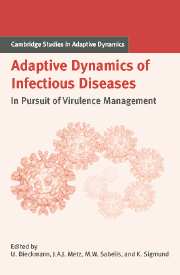Book contents
- Frontmatter
- Contents
- Contributing Authors
- List of Boxes
- Notational Standards
- 1 Introduction
- A Setting the Stage
- B Host Population Structure
- C Within-Host Interactions
- Introduction to Part C
- 9 Super- and Coinfection: The Two Extremes
- 10 Super- and Coinfection: Filling the Range
- 11 Multiple Infection and Its Consequences for Virulence Management
- 12 Kin-selection Models as Evolutionary Explanations of Malaria
- D Pathogen–Host Coevolution
- E Multilevel Selection
- F Vaccines and Drugs
- G Perspectives for Virulence Management
- References
- Index
- International Institute for Applied Systems Analysis
11 - Multiple Infection and Its Consequences for Virulence Management
Published online by Cambridge University Press: 15 January 2010
- Frontmatter
- Contents
- Contributing Authors
- List of Boxes
- Notational Standards
- 1 Introduction
- A Setting the Stage
- B Host Population Structure
- C Within-Host Interactions
- Introduction to Part C
- 9 Super- and Coinfection: The Two Extremes
- 10 Super- and Coinfection: Filling the Range
- 11 Multiple Infection and Its Consequences for Virulence Management
- 12 Kin-selection Models as Evolutionary Explanations of Malaria
- D Pathogen–Host Coevolution
- E Multilevel Selection
- F Vaccines and Drugs
- G Perspectives for Virulence Management
- References
- Index
- International Institute for Applied Systems Analysis
Summary
Introduction
Many parasites exploit their host in order to accomplish within-host reproduction and allow transmission to new hosts. However, an extreme exploitation strategy may incur a cost since it might decrease the life expectancy of the host and, as a consequence, the chances of the parasite being transmitted. In this respect, virulence (i.e., the deleterious effect induced by the parasite) can be considered a byproduct of the parasite's host-exploitation strategy. Such a trade-off leads to the conclusion that parasites should evolve toward intermediate levels of virulence. This idea has been formalized by several authors (Anderson and May 1979; Ewald 1983; Van Baalen and Sabelis 1995a; Frank 1996c), who found that an evolutionarily stable level of virulence depends on several life-history parameters for both the host and parasite, as well as some constraints (such as the classic trade-off between transmission ability and virulence).
Moreover, it has been shown that multiple infections (i.e., the ability of the parasite to infect an already infected host) increase within-host competition and select for higher levels of virulence (Eshel 1977; Bremermann and Pickering 1983; Frank 1992a, 1994b, 1996c; Nowak and May 1994; May and Nowak 1995; Van Baalen and Sabelis 1995a). Several models have been developed around this idea (see Box 5.1), but we believe the kin-selection model proposed by Frank remains the simplest way to address this question (but see Box 11.1). Frank formalized the idea that there is a strong analogy between the evolution of altruism and that of parasite virulence.
- Type
- Chapter
- Information
- Adaptive Dynamics of Infectious DiseasesIn Pursuit of Virulence Management, pp. 150 - 164Publisher: Cambridge University PressPrint publication year: 2002
- 5
- Cited by



